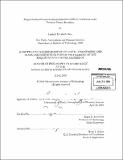| dc.contributor.advisor | Roger E. Summons. | en_US |
| dc.contributor.author | Hays, Lindsay Elizabeth | en_US |
| dc.contributor.other | Massachusetts Institute of Technology. Dept. of Earth, Atmospheric, and Planetary Sciences. | en_US |
| dc.date.accessioned | 2010-10-29T18:27:45Z | |
| dc.date.available | 2010-10-29T18:27:45Z | |
| dc.date.copyright | 2010 | en_US |
| dc.date.issued | 2010 | en_US |
| dc.identifier.uri | http://hdl.handle.net/1721.1/59738 | |
| dc.description | Thesis (Ph. D.)--Massachusetts Institute of Technology, Dept. of Earth, Atmospheric, and Planetary Sciences, 2010. | en_US |
| dc.description | Cataloged from PDF version of thesis. | en_US |
| dc.description | Includes bibliographical references. | en_US |
| dc.description.abstract | The extinction at the Permian-Triassic boundary marked one of the most profound events of the Phanerozoic Eon. Although numerous hypotheses have been proposed, the trigger mechanism continues to be debated. This thesis intends to examine the impact of oceanic conditions on the extinction event by analyzing hydrocarbon biomarkers. Hydrocarbon biomarkers are chemical fossils in sedimentary rocks that serve as proxies to measure the conditions that prevailed during deposition. In this thesis, biomarkers for redox conditions, depositional environment, microbial community and potential age-related biomarkers have been measured and are reported from four sections that span the Permian-Triassic boundary. The first section, from the Peace River Basin in modern-day western Canada, was deposited on the eastern margin of the Panthalassic Ocean and samples conditions in this global water body. The second section is from Kap Stosch, Greenland, and was deposited on the southern margin of an epicontinental sea situated in the northwest of the supercontinent Pangaea. The Great Bank of Guizhou, China is the third section studied, and it is a carbonate platform deposited on the southern edge of one of the smaller continental blocks that formed the eastern margin of the Paleo-Tethys Ocean. The fourth section, for the Permian-Triassic boundary is from Meishan, China, the type section for this boundary, and was deposited on the western margin of another one of the continental blocks at the edge of the Paleo-Tethys Ocean. The biomarker evidence from these sections was measured in ratios, absolute abundances and for 613C isotopic values. This evidence points to global marine conditions dominated by bacterial inputs in which photic zone euxinia was prevalent for extended time periods. Additional findings from compound-specific isotope data suggest that at isolated intervals, the chemocine may have extended even closer to the surface. The timing of these intervals implies that ocean conditions may have affected the extinction itself. | en_US |
| dc.description.statementofresponsibility | by Lindsay Elizabeth Hays. | en_US |
| dc.format.extent | 287 p. | en_US |
| dc.language.iso | eng | en_US |
| dc.publisher | Massachusetts Institute of Technology | en_US |
| dc.rights | M.I.T. theses are protected by
copyright. They may be viewed from this source for any purpose, but
reproduction or distribution in any format is prohibited without written
permission. See provided URL for inquiries about permission. | en_US |
| dc.rights.uri | http://dspace.mit.edu/handle/1721.1/7582 | en_US |
| dc.subject | Earth, Atmospheric, and Planetary Sciences. | en_US |
| dc.title | Biogeochemical proxies for environmental and biotic conditions at the Permian-Triassic boundary | en_US |
| dc.type | Thesis | en_US |
| dc.description.degree | Ph.D. | en_US |
| dc.contributor.department | Massachusetts Institute of Technology. Department of Earth, Atmospheric, and Planetary Sciences | |
| dc.identifier.oclc | 670426704 | en_US |
